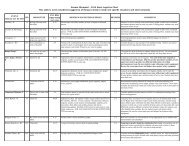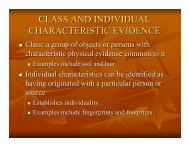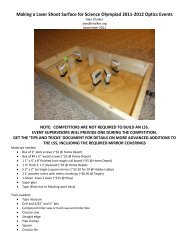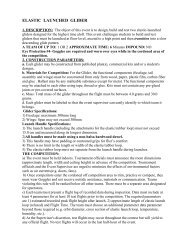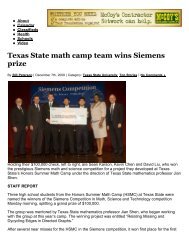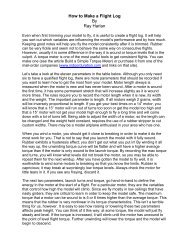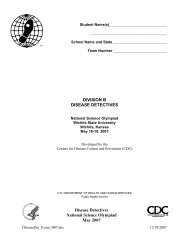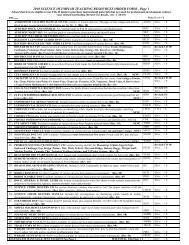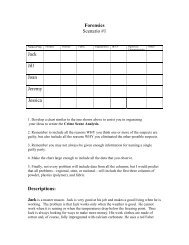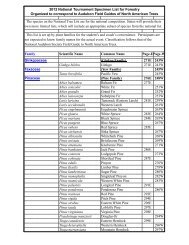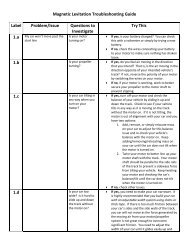Introduction-Forensic Science 1. Introduction of topic a. Definition of ...
Introduction-Forensic Science 1. Introduction of topic a. Definition of ...
Introduction-Forensic Science 1. Introduction of topic a. Definition of ...
Create successful ePaper yourself
Turn your PDF publications into a flip-book with our unique Google optimized e-Paper software.
<strong>Introduction</strong>-<strong>Forensic</strong> <strong>Science</strong><strong>1.</strong> <strong>Introduction</strong> <strong>of</strong> <strong>topic</strong>a. <strong>Definition</strong> <strong>of</strong> <strong>Forensic</strong> <strong>Science</strong>-Uneasy/unholy marriage<strong>of</strong>i. <strong>Science</strong>-the objective seeker <strong>of</strong> truth &knowledgeii. <strong>Forensic</strong>s-the argumentative persuader <strong>of</strong>courtroom advocacyb. Prefer to think <strong>of</strong> ourselves as our Mother’s Child-Mother <strong>Science</strong>i. Pureii. Incorruptibleiii. Firmly rooted in Scientific Methodc. Lots <strong>of</strong> pressure from detectives, police departments,lawyers for “Bad <strong>Science</strong>”i. Have students comment on each <strong>of</strong> theseexamples <strong>of</strong> “Bad <strong>Science</strong>”<strong>1.</strong> There is an old Bad <strong>Science</strong> joke about ascientist who was working with an ant. Thescientist would cut <strong>of</strong>f one <strong>of</strong> the ant's legsand shout, "Jump!" And the ant would jump.The scientist cut <strong>of</strong>f a second leg, and toldthe ant to jump, and again the ant jumped.And so it went, until the scientist had cut <strong>of</strong>fall six <strong>of</strong> the ant's legs. This time, when toldto jump, the ant did not jump. This proves it,the scientist concluded, when you chop allthe ant's legs <strong>of</strong>f, it becomes deaf!2. Misinterpretation <strong>of</strong> Test Results - In arobbery trial, the victim, a bartender testifiesthat the defendant had come into the tavernearlier in the night for a glass <strong>of</strong> beer. Threeunwashed glasses were found at the scene,seized, and later processed for fingerprints.
Two <strong>of</strong> the glasses yielded prints, but theybelonged to persons unknown - not thedefendant. The prosecutor suggests that thefingerprint examiner testify that the thirdbeer glass must have been used and thenwiped clean by the defendant, because theother two glasses were obviously not usedby him. The fingerprint examiner suggeststhat the prosecutor look elsewhere for thiskind <strong>of</strong> testimony. The prosecutor lookssurprised.3. Manipulation <strong>of</strong> Raw Data - An accidentreconstruction expert with a computer ishired by a plaintiff's attorney to determinethe speed <strong>of</strong> the defendant's vehicle in atwo-car collision. The expert enters into hiscomputer program the road surface dragfactor, skid and yaw mark lengths, and thelocation and severity values <strong>of</strong> the vehicledamage. The first run <strong>of</strong> his computerprogram produces an unrealistically highspeed for the defendant striking vehicle. Theexpert changes his drag factor estimates andtries again. The figures are still outrageous.Three program runs and several crush datachanges later, the speed determinationbegins to look more believable. Thedefendant's attorney begins his attack <strong>of</strong> thetests with a subpoena for all five <strong>of</strong> theexpert's computer printouts.4. Comparing Apples and Orangutans - In aproduct liability suit, the plaintiff's attorneyfinds an expert who will testify that, if theshotgun involved in the shooting had as safe
a firing mechanism as a rivet gun, theincident may not have happened at all.5. Manipulation <strong>of</strong> Test Results - During aburglary trial, the prosecution producesseven latent fingerprints which wererecovered from inside the victim's house.The fingerprint examiner testifies that he hasidentified these prints as belonging to thedefendant. The prosecutor testifies that thefingerprints are like seven differentphotographs <strong>of</strong> the suspect inside the house.Because he does not want a repeat <strong>of</strong> anearlier case lost to the defense attorney, theprosecutor calls a second examiner to thestand to verify the comparisons made by thefirst. The prosecutor then states that theseven fingerprints, times two examiners,make fourteen little photographs <strong>of</strong> thesuspect inside the house. Later, when askedwhy he didn't call a third examiner to up thescore to twenty-one fingerprints, theprosecutor replies that he had simplyneglected to subpoena a third examiner.6. Compulsive Computing - A .223Remington bullet is found lodged in the side<strong>of</strong> a house several hundred feet to the rear <strong>of</strong>a rifle practice range where .223ammunition is frequently used. Theinvestigators want to know if a it is possiblefor a .223 bullet to fly the several hundredfeet necessary to reach the house from therange, so they ask a firearms examiner. Theexaminer, who ha recently invested in aballistics program for his home computer,took down the range, wind speed, bullet
shape, temperature, barometric pressure, andseveral other pieces <strong>of</strong> data. His computercharted the results. Finally his answer to theinvestigator was, "Yes, it is possible." As aqualified firearms examiner, he had alreadyknown that the house was well within therange <strong>of</strong> the .223 bullet and could havegiven the same answer when first asked thequestion...without computation.7. Denial - In many major criminalinvestigations, it is the practice <strong>of</strong> detectivesto <strong>of</strong>fer a polygraph examination to thesuspect, and, in cases <strong>of</strong> questionableaccusations, to the victims. While they arenot admissible in court, the polygraphresults are relied upon as a valuableinvestigative tool. One day a young police<strong>of</strong>ficer shoots and wounds a juvenile who heclaims fired upon him first, although noweapon was found. The <strong>of</strong>ficer claims hewas also struck several times about the headand shoulders with a board prior to theshooting, although he exhibits no bruises,head injuries, or defense injuries to hishands or arms. When asked about this lack<strong>of</strong> consistent injuries, a detective reports thatthe <strong>of</strong>ficer was wearing a bullet resistantvest. The detectives do not <strong>of</strong>fer the suspector the police <strong>of</strong>ficer a polygraphexamination in this particular case.8. No Scientific Methodology - A city truckdriver runs a stop sign and causes anaccident which results in severe injuries.Instead <strong>of</strong> relying on skid marks, crushdamage, and scene evidence, the city
authorities order a traffic investigator toconduct acceleration tests to determine themaximum possible speed the truck couldhave achieved in the one-block distanceleading up to the crash. Because the truckwas disabled in the crash, the trafficinvestigator uses a motorcycle to run theone-block acceleration test and reports backa peak speed <strong>of</strong> 35 miles per hour for thecity truck.9. Too Many Cooks Spoil the Broth - A citybus rear-ends a carload <strong>of</strong> teenagers, killingfour. The first traffic investigators at thescene measure the skid marks <strong>of</strong> the bus anddetermine that the bus driver was speeding.A national civil rights leader claims that thebus driver is being made a scapegoat by thecity solely because he is <strong>of</strong> a racial minority.The follow-up investigation by the cityauthorities reports that the original trafficinvestigators, who have been abruptlyremoved from the case, must have beenmeasuring tire marks tracked through meltedroadway tar and that, on second thought, thecity bus driver was not speeding. A localtelevision station gets a radar gun andreports that most drivers, including city busdrivers, regularly exceed the speed limit onthis stretch <strong>of</strong> road. Tire tracks in tar looknothing like skid marks to the trained eye <strong>of</strong>the investigator. Excessive speed aside, it isunlawful to follow another vehicle at anunsafe distance.10. Pursuit <strong>of</strong> the Inconsequential - In thefaked robbery <strong>of</strong> a fast food restaurant, the
night manager shoots to death an employeein a walk in cooler, hides the "stolen" moneyand a .357 magnum revolver and callspolice. The crime scene personnel noticefallen dust on a restroom floor and discoversthe money hidden in a ceiling panel. Therevolver is found among the night manager'spossessions. In preparation for the trial, theprosecutor asks for a shooting sound test tobe done inside the restaurant's walk incooler. This, he says, will determine whetheror not the fatal shots could have been heardby a teenage girl who was having sex with aman (not her boyfriend) in her boyfriend'svan parked across the street from therestaurant. The girl, who incidentally had afull length cast on her leg at the time(another mystery altogether), did not recallhearing much <strong>of</strong> anything, least <strong>of</strong> allgunfire. Her partner that night also somehowmissed the sounds. The crime sceneinvestigator refused to participate in such anexperiment, arguing that it was irrelevant,invalid, and just plain silly...and what wouldit prove, anyway? The prosecutor suggeststhat the defense might use the fact that thegirl had not heard the shots to argue that thetime <strong>of</strong> the murder was somehow different."Then let the defense make a sound test,"the investigator says, leaving. Theprosecutor is insistent. After being turneddown by the police firearms instructor andthe state regional laboratory examiners, theprosecutor gets three detectives to fire theshots for the sound test. To duplicate the
sounds <strong>of</strong> a .357 magnum, they load theweapon with light .38 special target loads;they fire the quieter ammunition into asandbagged pipe inside the walk in cooler soas not to make holes in the walls. It isseveral months later, and the air temperatureis sixty degrees cooler than the night <strong>of</strong> themurder. By the time the test begins, thenoisy morning rush hour traffic has cloggedthe street in front <strong>of</strong> the restaurant. Toduplicate the hearing <strong>of</strong> the busy girl withthe cast on her leg and other things on hermind, they use the prosecutors ears as hestands across the street. (Later there wereseveral pr<strong>of</strong>ane allegations about what theprosecutor had to endure to fully recreate theevent.) The results <strong>of</strong> the test? "It soundedlike a hand clap," said one <strong>of</strong> the detectivesstationed in the restaurant's dining room. So,apparently one can induce deafness bymaking love to a girl in a full-length cast,the same as one can by cutting all six legs<strong>of</strong>f an ant.ii. To Prevent “Bad <strong>Science</strong><strong>1.</strong> The first is the methodological battle plancalled "Ockham's Razor," named after the14th century philosopher William <strong>of</strong>Ockham. In philosophy, a problem shouldbe stated in its basic and simplest terms. Inscience, the theory that fits the facts <strong>of</strong> aproblem with the fewest number <strong>of</strong>assumptions is the one that should beselected. This is the great-grandfather <strong>of</strong>K.I.S.S. (Keep It Simple, Stupid) theory, andit works well against Bad Scientists.
2. The second tactic is termed "reducio adabsurdum," which is the dispro<strong>of</strong> <strong>of</strong> aproposition (or stupid experiment) byshowing the absurdity to which it leadswhen carried out. A good example <strong>of</strong> such asituation is the aforementioned case <strong>of</strong> theprosecutor who argued that sevenfingerprints identified by two fingerprintexaminers make a total <strong>of</strong> fourteen littletraces <strong>of</strong> the burglary defendant. Thereduction ad absurdum <strong>of</strong> that case is thenotion that a third fingerprint examinerwould up the ante to twenty-one clues, orthat a dozen examiners identifying a singleprint would make for twelve traces <strong>of</strong> thedefendant. The clues multiply like bunnyrabbits. The mind boggles. Think <strong>of</strong> wherethe Bad Scientist is trying to lead you. Andlook to the dark at the end <strong>of</strong> the tunnel.3. The final fallback is to common sense, thebane <strong>of</strong> Bad Scientists the world over. It wasThomas Huxley who said, "<strong>Science</strong> issimply common sense at it's best - that isrigidly accurate in observation, andmerciless to fallacy in logic." This is wherethe juries trod on the best laid plans <strong>of</strong>eloquent attorneys. They step back for amoment and resort to instinct, to commonsense. Lawyers, especially those truebelievers who do the prosecuting, arenotoriously bad at feigning common sense.They are better at reduction ad absurdum.Cops, on the other hand, are excellent atinstinct and common sense, but poor at
seeing the absurdity <strong>of</strong> a proposition'slogical conclusion.2. Observation-The first step to good scientific investigationa. Use the How observant are you? activity to demonstrateto the students that memory is not literal. We do notremember exactly what we see, our memories areaffected by opinion, expectation, and other subjectivefactors.i. This activity demonstrates our ability toremember details accurately. Testimony aboutpersonal experience is frequently used during aninvestigation. How accurately do peopleremember what they have seen? What factors mayplay a role in what we can remember and describeabout something we have witnessed? Considerthese questions as you do the following activity.<strong>1.</strong> Pass out the pictures face down. At yoursignal have students turn the picture overand look at it for 30 seconds. Have themturn the papers back over and collect them2. Ask the class to write on another sheet <strong>of</strong>paper the answers to these questionsa. What time was it on the clock?b. How many people were in the scene?How many males? females?c. Describe the person at the front <strong>of</strong> theline. Was it a man or a woman? Washe or she wearing a hat? What kind <strong>of</strong>clothes was the person wearing? Couldyou tell how tall the person was? Didhe or she have any distinguishingfeatures?d. What day <strong>of</strong> the month was it?e. Did you notice anything unusual in thepicture?
3. Have the class give you the answers to puton the board.4. If you wish/time permits, you can pass outthe pictures again for the students to look atwith the questions in handb. Have the students discuss the factors that may affectmemory. Then, use the How observant are otherpeople? activity to allow the students to see howeyewitnesses may not be reliable.i. As you experienced, your own memory cansometimes fool you. But what about otherpeople's memories? Try out this exercise to seehow witnesses to the same science rememberdifferent details. Think about how useful anindividual's testimony can be. Does it help to haveseveral witnesses to a scene?<strong>1.</strong> Divide the class in half, thirds, or fourthsdepending on the size <strong>of</strong> the class. You want6-8 people per group.2. Have two <strong>of</strong> each group be the detectives.The rest are the eye-witnesses to a scene.3. Have the detectives all go out in the hall fora couple <strong>of</strong> minutes4. Pass out the second set <strong>of</strong> pictures facedown.5. Have the students turn them over and look atthem for 30 seconds. Have them turn themface down and collect them.6. Have the detectives come back in and go totheir group. Each detective should questioneach witness. Have the detectivesreconstruct the scene. If the detectives needsome help coming up with questions to asksuggest:
a. How many people were involved inthe scene?b. What can you tell about eachindividual's hairstyle, gender,approximate age, etc.c. Was there anything unusual going on?7. Compare the reconstructions <strong>of</strong> the groupswith each other and the original. Do moreeye-witnesses help or hurt?3. Perceptual Fallaciesa. Our normal perceptions do not correspond directly toreality. The things that we perceive (see, hear, smell,etc.) are not entirely determined by what our sensesdetect. Our perceptions are also determined by what weexpect, what we know, what we believei. Our perceptions are not photographs they areconstructions- something that our mindsmanufactureii. what we perceive is partially determined by whatwe know or believeiii. constructive perception has survival value - helpsus make sense <strong>of</strong> the worldiv. So, seeing is not necessarily believingb. Our tendency to have perceptual experiences in theabsence <strong>of</strong> stimulii. color constancy<strong>1.</strong> We <strong>of</strong>ten perceive an object to be a colorbecause we expect it to be a certain color.EXAMPLE: If you have a cutout or a treeand a donkey both made from greenmaterial, and lit by red light, people will<strong>of</strong>ten perceive the cutouts as green trees andgray donkeys.2. You can have left brain/right brain conflictwhen reading words that are a certain color
3. Pass out sheets with words written in color.Have Students follow directions. CollectSheets4. We also perceive color sometimes when it isphysically impossible. EXAMPLE: Thevision cells in the center <strong>of</strong> the retina are theonly ones that can see color. Therefore, weshould only see color in the center <strong>of</strong> ourvisual field. Objects in our peripheral visionshould not appear in color. But we see colorthroughout the field. Why? Color constancy!Try looking at colored objects with yourperipheral vision - what do you see?ii. size constancy - learned perception (does a truckdriving in the distance get smaller?)<strong>1.</strong> You perceive the size <strong>of</strong> familiar objects(like a truck) to be the same size no matterhow far away they are because you knowthat distance doesn't change the size <strong>of</strong> anobject. However, the size <strong>of</strong> the image onyour retina shrinks as an object moves awayfrom you.2. There is a tribe called the Ba Mbuti thatprovide evidence that size constancy islearned. This tribe lives in a thick junglewhere they never are able to see more than afew yards away. When taken into a field andshown buffalo in the distance, they askedwhat kind <strong>of</strong> insects they were. When toldthat the animals were buffalo, the tribespeople thought it was witchcraft.c. Expectationi. We perceive what we expect to perceive<strong>1.</strong> Flashing light experiment- subjects weretold to walk down a hall and stop walking
when they saw a light flash. Many subjectsstopped walking despite the fact that n<strong>of</strong>lash was given. They simply expected aflash and believed they saw one. Similarexperiments have shown subjects who couldfeel warmth, smell an odor, or feel anelectric shock because they expected to.2. We have all experienced suchhallucinations. Have you ever seen thehands on a clock move only to find out thatthe clock didn't run? Have you ever heardthe phone ring when you were in theshower, but later found it had not rung atall?3. What other experiences have you had thatmay have been due to expectation?d. Looking for Clarity in Vaguenessi. When our senses are confronted with a formlessstimulus, we <strong>of</strong>ten perceive something distinct.We look at clouds, smoke, fuzzy paintings and seeshapes that are familiar. This illusion is calledpareidolia. Many cases <strong>of</strong> pareidolia are common<strong>1.</strong> Man in the Moon - cultural example2. Samoans see a woman weaving3. Chinese see a monkey pounding rice4. East Indians see a rabbit5. Jesus' image in a tortilla - famous case <strong>of</strong> ahousewife in New Mexico who found theshape in the skillet burns and took it as asign <strong>of</strong> Christ's second coming6. Messages in rock music7. Man in the shadows - Do you ever feel asthough someone is following you?8. UFOs - we try to make something familiarout <strong>of</strong> a vague object.
9. The Blondlot Case and N-rays - famous casein which scientist Rene Blondlot announcedthe discovery <strong>of</strong> N-rays, which could bedetected by the human eye and were emittedby metals. They apparently increased thebrightness. Blondlot claimed that this type<strong>of</strong> radiation was blocked by lead. Scientistscould not reproduce his results because theexperiments were entirely subjective.Another scientist named Wood challengedBlondlot while participating in a test <strong>of</strong> N-rays. He told Blondlot that a lead sheet wasin place when it was not, and Blondlotclaimed to see the rays. Wood then placedthe lead sheet in front <strong>of</strong> the source <strong>of</strong> N-rays and Blondlot claimed to see the N-rays.Blondlot's observations depended entirelyon his beliefs, and were not correlated towhen the sheet was actually in placee. Memoryi. our memories are constructive, not literalii. imagine a scene.......How do you look at it?iii. Recall a scene - do you look at it through yourown eyes?iv. Car accident film - hit vs. smash and long termmemory - if people watch a car accident on filmand are asked a question after viewing the scene,the wording <strong>of</strong> the question affects how thesubject remembers the scene. When asked "Howfast were the cars going when they smashed?",subjects reported faster speeds when asked aboutit again later than subjects who were asked, "Howfast were the cars going when they hit?"v. Selective memory - Dreams, we have over 250 anight but only remember a few <strong>of</strong> them, if any
f. Judgingi. We can lead ourselves to believe that something isparanormal or supernatural when it actually isn'tii. Have you ever had a friend call just when youwere thinking about them? It may seem strange orparanormal, but there are many more times whenyou think about someone or something andnothing related happens.iii. What are the chances that 2 people out <strong>of</strong> a party<strong>of</strong> 23 have the same birthday? 1/2-----1/1000-----1/40----- 1/2020 (Answer 1/2!)iv. How many things happen to you in the course <strong>of</strong> aday? Incredible pairings are more likely than youthinkg. <strong>Science</strong> is a systematic attempt to get around theselimitations. <strong>Science</strong> tries to remove personal experiencefrom the scientific process.i. Scientific Method<strong>1.</strong> State Problem using operationally definedvariables2. Form a hypothesis3. Determine the variablesa. Independent variable(s)b. Dependent variable(s)c. Control(s)d. Standards <strong>of</strong> comparison(Experimental control)4. Determine the materials and procedures5. Make qualitative observations6. Obtain quantitative data7. Analyze and interpret the results8. Identify possible sources <strong>of</strong> error in theexperiment9. Write a conclusion10. Determine other tests to be done
4. Have Students start hand writing analysis for next daya. Pass out a check to each student and have them endorsethe back using the name <strong>of</strong> the payee (forge thesignature)b. Collect the endorsed checks keeping the groups separatec. Have each student write this note on a piece <strong>of</strong> paperDear Mr. Miller,Please excuse Allison from school yesterday. She was sickwith a high fever.Sincerely,Mrs. Smithd. Collect the excuses keeping the groups separate5. The Wife Puzzlea. Use if there is more time. Adjust instructions to timeavailable-can be take home problem to work on for nextdayi. A lovely cashmere sweater was found torn toshreds (What a Crime!!) on the sidewalk in theinternational quarter.ii. The sweater police talked to six witnesses,including the shredder. The six were very openabout what had happened. The only trouble wasthat none <strong>of</strong> them spoke any language the policecould understand. Nevertheless, the police wereable to piece together the following information<strong>1.</strong> The witnesses were three men and threewomen: Fred, John and William; Gloria,Gilda, and Barbara2. The men were married to the women,though not necessarily in the order listed3. William's wife was the cashmere murderer4. Fred speaks and understands only Basque5. John is bald
6. The couple who live next door to Gilda andher husband have the same color hair shedoes, and speak both Spanish and Basque.7. William's wife recently gave Barbara ahome permanent8. Gilda's husband speaks only Frenchiii. Who destroyed the lovely sweater?iv. Solution to the Wife Puzzle<strong>1.</strong> If you can identify William's wife, you'llknow the shredder2. William's wife isn't Barbara, because theformer gave the latter a permanent.William's wife must be either Gilda orGloria3. Fred's wife isn't Gilda, because he speaksonly Basque and her husband speaks onlyFrench. So Fred's wife is either Gloria orBarbara.4. If John is bald, he doesn't live next door toGilda and he doesn't speak Spanish andBasque.5. Therefore, John must speak French and bemarried to Gilda. Only Gloria can beWilliam's wife and the horrible cashmereshredder.6. Time left over? Have students introduce themselves to classMaterials Needed:Bank Observation PictureMeal Observation PictureWords in Color SheetBank Checks



